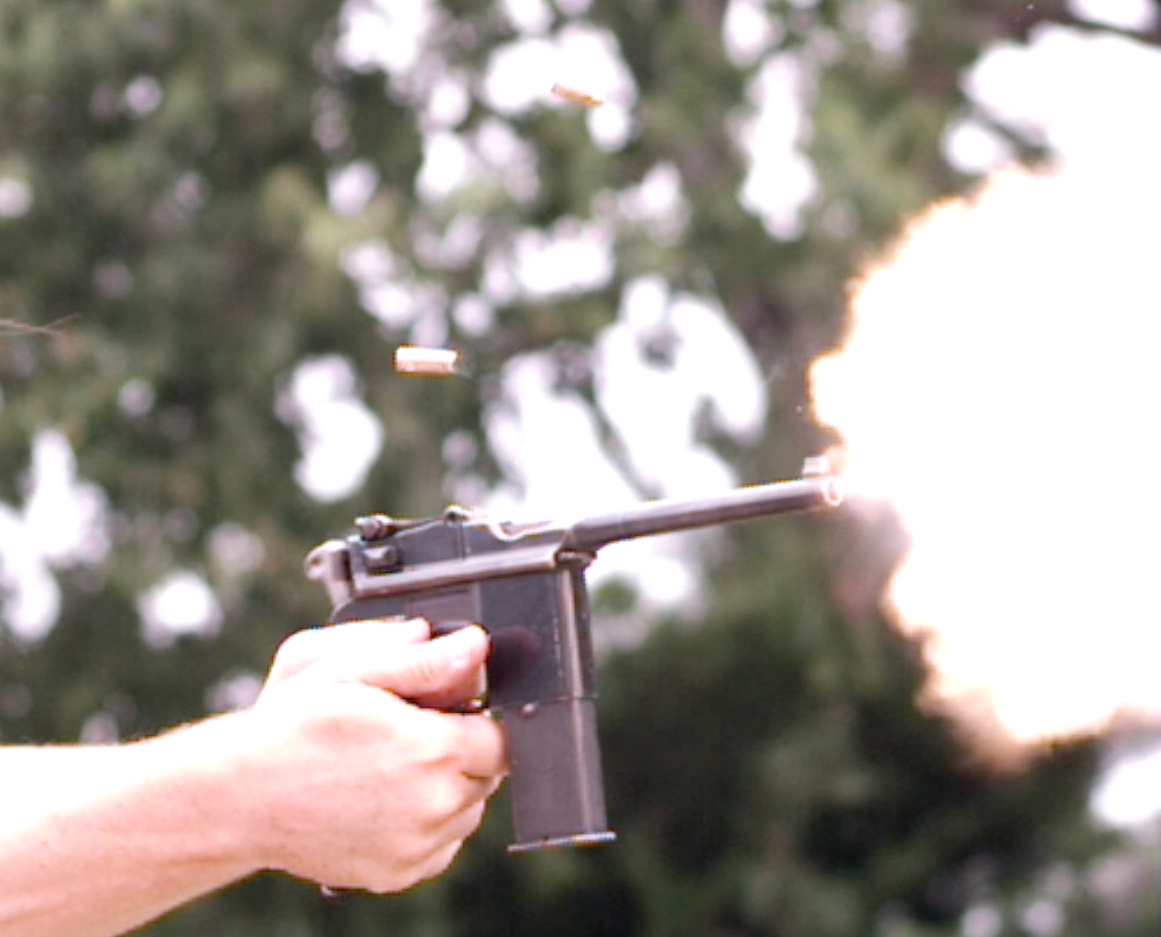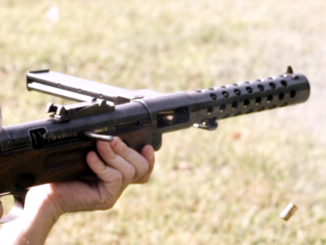We have another experimental German WWII piece for you today, Mauser’s last-ditch “Volkspistole”. It was developed at the end of the war as an extremely inexpensive home guard weapon, although how much use a pistol would have been in fighting off the Red Army and US Army is pretty questionable. The program was also undertaken by Walther and Gustloffwerke, but this particular gun was designed and built by Mauser. Like the VG1-5 rifle, it was designed to use gas ports in the barrel to delay opening of the breech, although it was later reworked as a simple direct blowback action. The design never went past the prototype stage because of the end of the war, but the theory can be seen turning up later in the H&K P7 and Steyr GB handguns.




Facsinating, thank you. Reminds me, mostly in profile, of the Bryco 59 type pistols that used to be manufactured and sold here in the U.S. Utility questionable, but cheap, easy and fast to make. The thought to make and issue this pistol might of been for use as a hideout to be able to kill occupying soldiers and then take their weaponse etc. Much along the same lines as the thought behind the U.S. Liberator pistol.
Nice really interesting!
Its hard to find good infor on the experimental german WW2 guns. So it is really nice that you are doing this.
Btw Volk is pronounced Folk, in German most V are pronounce as F and the use W (double V) for V. Wich you notice when germans speak english 🙂
How depressing it must have been for the engineers to get that design request.
On the other hand, no design request would have meant being drafted into a Wehrmacht suffering heavy losses.
I would be interested to know if Gaston Glock got some inspiration for his firing mechanism from this pistol?
Glock system is bas on Autrian Roth-Steyr M1907
Thank You! I always wondered about that threaded smooth bore barrel on the end of the pistol.
The whole Volkspistole program is fascinating. They even made a sheet metal Mauser HSC.
A very fascinating weapon. I have a soft spot for Mauser, especially their pistols but that’s one’ll likely never have 🙂 Lots of interesting ideas rolled into one. I’m surprised more of them weren’t in use much sooner considering how the various advanced ideas in rifle design were quickly put to use (roller block, sheet metal, intermediate cartridges, etc).
Still and all, I think I’d prefer my 1942 civilian production HSc to this volkspistole!
I’v always thought that stamped steel pistols are fascinating. I hope that you had the opportunity to take some photos, because detailed photographs of any last ditch German firearm are few and far between.
I am most curious to see if the trigger mechanism shares any similarity with that of the VP70. They were both designed to be cheap and fast to manufacture, and simple enough for anyone to use against an invading army of Soviets. I wonder if someone at HK remembered the Volkspistole and tried to resurrect it.
H&K wase forme many former emplyees of Mauser Werk
Is it just me, or does the frame strongly resemble the pistol grip and control group of the Stürmgewehr 44? If so, might that have been a reason to consider a pistol design at all during the belated decision to go from 7.92x57mm rifles and 9x19mm submachineguns/”Maschinenpistolen” to 7.92x33mm Kurz?
That sear sure is simple!
It’s even more interesting than I expected.
What sort of effort was needed to cycle the slide?
Thanks for sharing
ps
I’ve never fired a plain blowback 9mm P, some accounts I’ve read(for example of Astra and Campo Giro type pistols) suggest a lot of felt recoil compared to locked breech or gas buffered actions, allong with difficult cycling because of the meaty recoil spring and it’s high pre-load.
has anyone here experience with these?
Thinking about that striker mechanism;
Is the final part of the striker travel to the primer – by momentum alone?
I’m guessing that it has a spring to retract the striker back into the bolt face after firing too?
did you get to disassemble and photograph the striker innards?
http://fastmarksman.ru/VEGA.htm
this web have a cutaway.
http://xn--80aaxgqbdi.xn--p1ai/publ/8-1-0-171
There is a cutaway, as well as other weapons of the experiment.
I also remembered punching 1911 pistol
us7353742
http://www.freepatentsonline.com/7353742.html
us7987763
http://www.freepatentsonline.com/7987763.html
The same patented design
Thanks Mark.
Trigger mechanism looks very similar to the French “La Francais” pistol of 1914
with a cleverly simplified striker construction having no underlug for trigger
contact. Striker should be simply drawn from a turning lathe or rollers like a
screw machine. Trigger bar has twin sears at each sides aroused to catch the
cylindirical body of striker.
Gas ports at each side in front of the chamber should work to slow down the speed
of slide as sinking in counter holes, and also lessening the bullet velocity to
get milder recoil force as well. Same concept is used in a little pistol nowadays
branded “Kevin” made in Czech Republic.
Frame is stamped steel, what about the slide, machined or stamped with machined insert (part with firing pin) ?
What is the weight of the slide and whole gun ?
Why do you think this would not be a sufficent Army sidearm?
Guess that these expedient and cheap firearm ideas came a bit “too little, too late”, after spending many millions of Reichmarks on for (drastic) example futile and war effort unsucessfull V2 project.
Germany from the beginning entered a war without enough weapons (for the needed troops size), thats why they so much adopted, used and numerated many captured foreign weapons, sometimes rebarreling them like ppsh41.
Makes a good lesson in war logitics and economic priorities : make a few high quality,expensive and modern firearms (after spending even more money on R&D), or a thousands of cheap,ugly and simple ones based on (copied) existing designs ??
THINKING ABOUT BUYING MAUSER HSC 380 BELIEVE IT WAS MADE IN THE 70’S. ARE THE FRAMES MADE OUT OF STEEL?
THANK YOU,
RON